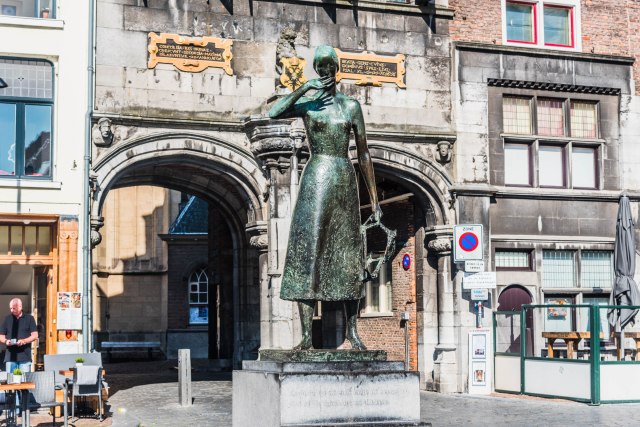
This bronze statue has been on Nijmegen’s Grote Markt, by the entrance to the Stevenskerk, since 1956 and was executed by Vera Tummers-Van Hasselt. It represents Mariken van Nieumeghen (Little Mary of Nijmegen) one of the symbols of the city in one of the best loved pieces of medieval Dutch literature.
According to a miracle play probably written between 1485 and 1510 in Antwerp, Mariken lived with the devil for seven years. Mariken had to go into town to do some shopping for her uncle. By the time she finished, it was already too late to go home, and she was not welcome to stay with her aunt in the city.
Wandering through the countryside, she met the Devil, who presents himself as Moenen. Moenen persuaded Mariken to accompany him to Antwerp. There, they led a very dissolute life for years. But Mariken wanted to see her family again. Together Mariken and Moenen returned to Nijmegen. Once there, Mariken sees a pageant, which demonstrates that everyone can receive forgiveness from God for their sins, which brings Mariken to repentance.
Moenen, who sees this happening, tries to kill her by dropping her from high in the air, but Mariken survives, and asks for forgiveness for her great sins everywhere. Moenen keeps trying, and failing, to kill her.
The Pope says Mariken’s sins will not be forgiven until the three rings, which she must wear on her arms and neck, fall off automatically, through the help of God.
One morning, Mariken, who has entered a convent, wakes up and notices that the rings have fallen off. God has forgiven her!
On the plinth are two lines from the story, which Mariken says when she has left Nijmegen as a little girl and is crying under a bush:
Comt nu tot mi ende helpt mi beclaghen,
God of die duvel, tes mi alleleens.
(I think – although translating Medieval Dutch is not my strong point – this is loosely “My end is coming, give aid to my complaint, God or the devil, for I am alone.)
The devil hears the cry for help and knows how to win Mariken for himself. And appropriately, the statue is overshadowed by the text of the 150th Psalm, for this little tale is truly something to praise God for! And another thing is that this charming early modern entrance to the church was one of the few things in the city centre to survive the devastating American air raid 1944 unscathed.





